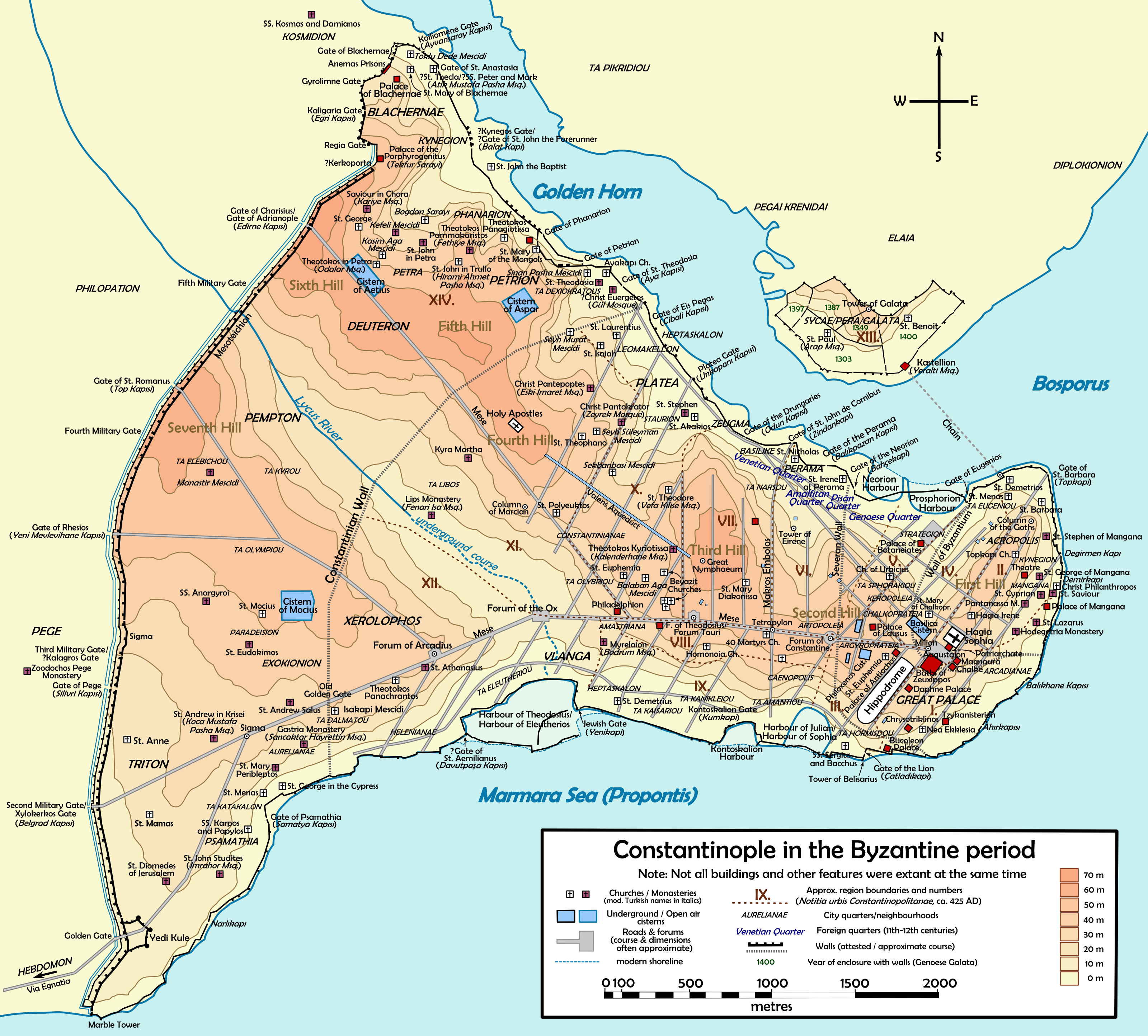Mese (Constantinople) on:
[Wikipedia]
[Google]
[Amazon]
 The ''Mese'' ( ''i Mése dós', lit. "Middle treet) was the main thoroughfare of ancient
The ''Mese'' ( ''i Mése dós', lit. "Middle treet) was the main thoroughfare of ancient
 The ''Mese'' ( ''i Mése dós', lit. "Middle treet) was the main thoroughfare of ancient
The ''Mese'' ( ''i Mése dós', lit. "Middle treet) was the main thoroughfare of ancient Constantinople
Constantinople (#Names of Constantinople, see other names) was a historical city located on the Bosporus that served as the capital of the Roman Empire, Roman, Byzantine Empire, Byzantine, Latin Empire, Latin, and Ottoman Empire, Ottoman empire ...
and the scene of many Byzantine imperial processions. Its ancient course is largely followed by the modern ''Divan Yolu'' ("Road to the Divan").
Route of the Mese
The ''Mese'' started at theMilion
The Milion ( or , ''Mílion''; ) was a marker from which all distances across the Roman Empire were measured. Erected by Septimius Severus in the 3rd century AD in the city of Byzantium, it became the zero-mile marker for the empire upon the r ...
monument, close to the Hagia Sophia
Hagia Sophia (; ; ; ; ), officially the Hagia Sophia Grand Mosque (; ), is a mosque and former Church (building), church serving as a major cultural and historical site in Istanbul, Turkey. The last of three church buildings to be successively ...
, and led straight westwards. It passed the Hippodrome and the palaces of Lausos and Antiochus, and after ca. 600 meters reached the oval-shaped Forum of Constantine where one of the city's two Senate houses stood. This stretch of the street was also known as the ''Regia'' (, "Imperial Road"), as it formed the original ceremonial route from the Great Palace and the Augustaion square to the forum of the city's founder.
From there, the street continued to the square Forum of Theodosius or Forum of the Bull (''Forum Tauri''), as it was also known. In about the middle of this stretch, the great mall known as ''Makros Embolos'' joined the ''Mese''. At their junction stood a tetrapylon known as the ''Anemodoulion'' ('Servant of the Winds).
Shortly after it passed the Theodosian Forum, the street divided in two branches at the site of the Capitolium: one branch going northwest, passing the Church of the Holy Apostles, towards the Gate of Polyandrion, while the other continued southwest, through the Forum of the Ox (Forum Bovis) and the Forum of Arcadius towards the Golden Gate, where it joined the '' Via Egnatia''.
The ''Mese'' was 25 metres wide and lined with colonnaded porticoes which housed shops. It was the route followed by imperial processions through the city at least until Comnenian times. The most characteristic such procession was the triumphal entry of a victorious emperor, who entered the city through the Golden Gate and followed the ''Mese'' to the Great Palace, while jubilant crowds lining the street would greet him and welcome the imperial army home.
Modern route
AsByzantium
Byzantium () or Byzantion () was an ancient Greek city in classical antiquity that became known as Constantinople in late antiquity and Istanbul today. The Greek name ''Byzantion'' and its Latinization ''Byzantium'' continued to be used as a n ...
went into decline so the Mese lost its importance. It was, however, revived after the Ottoman Conquest of Constantinople in 1453. Since the Ottomans
Ottoman may refer to:
* Osman I, historically known in English as "Ottoman I", founder of the Ottoman Empire
* Osman II, historically known in English as "Ottoman II"
* Ottoman Empire
The Ottoman Empire (), also called the Turkish Empir ...
chose to develop a new palace on more or less the same site as the Byzantines had done, the road leading from the Land Walls once again became important.
In the center of Istanbul, the street became known as Divan Yolu or the Road to the Divan, in recognition of the fact that dignitaries would process along it for meetings in the Divan inside Topkapı Palace (Topkapı Sarayı). So important was this road that to this day it is still lined with Ottoman monuments including mosques ( Firuz Ağa Mosque), libraries (Köprülü Kütüphanesi) and the tombs of some of the sultans, including Mahmud II
Mahmud II (, ; 20 July 1785 – 1 July 1839) was the sultan of the Ottoman Empire from 1808 until his death in 1839. Often described as the "Peter the Great of Turkey", Mahmud instituted extensive administrative, military, and fiscal reforms ...
, Abdülaziz and Abdülhamid II.
As it heads west Divan Yolu becomes Yeniçeriler Caddesi (Janissary Street) and then Ordu Caddesi (Army Street). From Beyazıt Square, which stands at the site of the old Forum of Theodosius, the northwestern branch of the Mese is traced by several streets, but mainly Fevzi Paşa Caddesi; the southwestern branch continues to follow Ordu Caddesi until it crosses Atatürk Boulevard, at which point it primarily traces Cerrahpaşa Caddesi and Koca Mustafapaşa Caddesi southwest towards the old Theodosian Walls.
The modern Divan Yolu is lined with cafes, restaurants, hotels, bookshops and other amenities aimed at tourists. Of passing interest on the modern street is the Lale Restaurant which was, in the 1970s, the famous Pudding Shop that served as a gathering place for hippies heading for Kathmandu
Kathmandu () is the capital and largest city of Nepal, situated in the central part of the country within the Kathmandu Valley. As per the 2021 Nepal census, it has a population of 845,767 residing in 105,649 households, with approximately 4 mi ...
and appeared in the Alan Parker film '' Midnight Express''.
The section of the former Mese east of Atatürk Boulevard (Divan Yolu, Yeniçeriler Caddesi and Ordu Caddesi) is by served Line T1 of the Istanbul Tram, between Aksaray station in the west and Sultanahmet station in the east.
References
Bibliography
* * {{Public spaces of Constantinople Constantinople Medieval roads and tracks